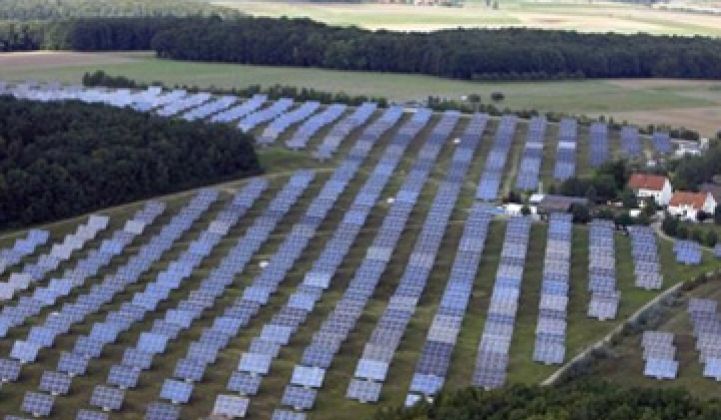Germany installed enough solar over the past year to warrant a 9 percent to 11 percent drop in solar power pricing in 2010. An anticipated change in policy may create a boom for the market for the first half of next year, an analyst said Friday.
The country,which is expected to be the largest market in 2009, saw about 2.34 gigawatts of new solar energy generation capacity between Sept. 30 2008 and Sept. 30 2009 (1.47 gigawatts from January to September this year), according to the Federal Network Agency. That surpassed the 1.5 gigawatts threshold before the new set of solar pricing, commonly referred to as feed-in tariff, could be in effect.
As a result, the pricing for rooftop systems will fall 9 percent while the ground-mounted systems will fall 11 percent starting in Jan. 1, wrote Alexander Karnick, an equity analyst at Deutsche Bank, in a research note.
The boom in Germany isn't surprising. Ever since Spain, the largest market in 2008, dramatically shrunk its feed-in tariff for 2009, companies and analysts have pegged Germany as the best market this year (see U.S. Solar Market: So Promising, Except for 2009).
Although the financial market crisis has made project financing difficult to come by worldwide, one could argue that its impact is more acute in the United States, where policies favor large-scale power plant projects that require millions of dollars to built.
Feed-in tariff policies require utilities to buy all the available solar electricity for sale at government-set prices, which are much higher than pricing for conventional power. This kind of incentive makes owning solar a profit-making enterprise, and attracts not just large power project developers but also homeowners and farmers.
A feed-in tariff policy is in place not only in Germany and Spain, but also in other European countries such as France, Italy and Czech Republic.
The United States doesn't have a national feed-in tariff policy, and the vast majority of states don't have them either. But many states do have laws requiring utilities to buy renewable energy, and those policies have prompted utilities to buy solar, wind and other renewable electricity from independent power producers – or build their own. Those power projects tend to be large, some in hundreds of megawatts.
Germany could see a lot more installations in the current, fourth quarter, Karnick noted. That could be partly driven by talks about a possible change to the feed-in tariff some time in 2010.
A federal election last month produced a new political coalition with leaders that have expressed misgivings in the past about whether the solar industry still needs the generous feed-in tariff to prosper.
There was some backlash against some Chinese solar panel makers for setting artificially low prices in order to take advantage of the feed-in tariff (see Germany Solar Incentive in Jeopardy? and Suntech to SolarWorld: Careful What You Wish For).
German lawmakers haven't said what changes they are considering. But the coalition did recently issue a policy framework that indicates the cuts to the feed in tariff would not be as drastic as some had feared.
"The political leadership understands that solar has created economic benefits and jobs," said Julie Blunden, vice president of public policy at San Jose, Calif.-based SunPower, during an interview at Solar Power International in Anaheim this week. "Making abrupt changes isn't a good way to maintain a healthy market."
Another factor that could drive more installations in the current quarter is weather. Germany is heading into winter, which typically halts solar energy installations.
During the winter, northern Europe is dead," said Rainer Gegenwart, CEO of Germany-based Masdar PV, during Solar Power International. "Everybody wants to bid in the fourth quarter, not the first quarter."
But Karnick cautioned against setting inflated expectations for the German market next year, and noted that the market still has an oversupply of solar panels.
"We got the impression that expectations are inflated mainly on the back of the German market acceleration in [the second half of this year], while other markets are still below expectations or behind schedule (i.e. US/China, Italy, France etc.)," Karnick wrote. "Hence, we remain cautious given structural oversupply weighing on ASP/margins and low visibility into 2010."



